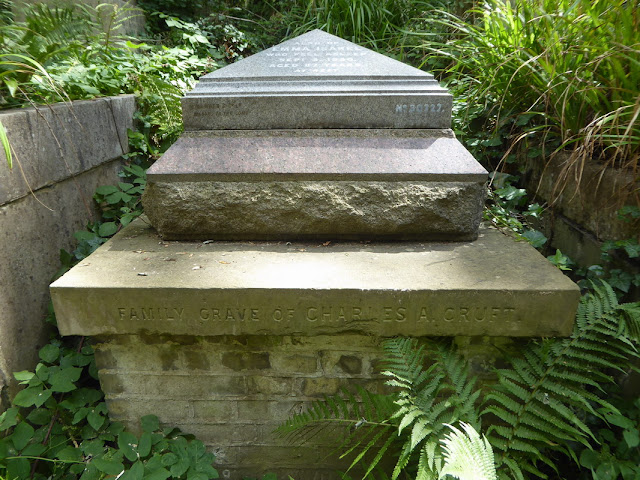The West Cemetery is the most famous of the two parts and has the most impressive architecture. These include the Chapel, Colonnade, Egyptian Avenue, Circle of Lebanon, Terrace Catacombs and the mausoleum of Julius Beer.
The cemetery is on a steep hill in a large wooden area. The whole cemetery is still used for burials and the West side is the most prestigious side to be buried. The recent graves are located alongside the paths in front of the first row of old graves. It is a private garden cemetery rather than a churchyard one. These private cemeteries were set up in the 1800s when the church graveyards became overcrowded and also unsanitary. In the 1830s and 1840s, eight such cemeteries were set up around London and were open to people of all denominations. Highgate was the third to open in 1839. London Cemetery is written over the gateway, this was the company that set up the cemetery.
At the ticket office, you are given a leaflet with a map showing notable graves and a brief description of the occupants.
Colonnade Path leads up the hill from the entrance. These graves all have different types of headstone
I was interested to see that a few Muslim names were in the cemetery. This grave is Dr Frederick Akbar Mohamed, an internationally known British Asian Muslim doctor who was known for his work on hypertension and preventative medicine, but died of typhoid aged 35. This is an interesting link about the forgotten history of Dr Mohamed
An ivy clad memorial -
A couple of modern graves along the pathway -
And at the first junction off Colonnade Path is Alexander Litvinenko grave. He was a former Russian intelligence agent granted asylum in Britain and later murdered by means of Polonium-210 in 2006. And coincidentally, two days after my visit, an article appeared in Sky News, "the polonium trail, how did the poison used to kill Alexander Litvinenko get to the UK".
George Hering was a landscape painter and is shown with an artist's palette and brushes -
At the next junction is the large sculpture for Elizabeth Godbee, showing a grieving widow holding a wreath and an inverted torch -
Nearby is Emma Wallace Gray and her headstone tells of her slow and agonising death -
The short Rossetti path leads to the Rossetti family grave. He was an Italian exile and his daughter Christina was a famous Victorian poet, she wrote "In the Bleak Midwinter".
Along Main Drive is Elizabeth Jackson, the first burial in Highgate, in 1839. She died of consumption. It was quite hard to spot in the undergrowth -
The pelican on Baroness De Munck represents sacrifice, of a mother for her daughter, enabling her to become a leading opera singer
This is the family grave of Charles Cruft, founder of the famous dog show. He died 1893 -
A couple of graves side by side -
The entrance to Egyptian Avenue -
This leads into the Circle of Lebanon
Looking into the Terrace Catacombs -
The large mausoleum Julius Beer had built for his daughter who died aged eight in 1875. He was a German born financier who owned the Observer and died in 1880 -
Ellen Wood's monument is based on the ancient Roman tomb of Cornelius Scipio Barbatus (died c. 280 BC) that had been recently discovered -
One of a few animal sculptures in Highgate West. George Wombwell (1777-1850) became a household name as owner of three large travelling animal shows, Wombwell's Travelling Menagerie. The sculpture represents Nero, his lion. Wikipedia has quite a detailed page on Wombwell.
I recently visited Abney Park Cemetery at Stoke Newington, this also has a grave with a lion sculpture, belonging to Frank Bostock who also travelled the world with a menagerie of animals.
Going back out of Egyptian Avenue -
Close by is the "Horse Grave", it is the burial site of the Atcheler family. Atcheler was the horse slaughterer to Queen Victoria. There are no horses buried here!
Behind is a magnificent horse chestnut tree and opposite is a redwood
Mary Nicols has a sleeping angel on a bed of clouds -
Sir Roland Hill was the founder of the "Penny Post". He was buried in Westminster Abbey but this grave is for his wife and family -
A couple of weeks ago I went to Trinity Lighthouse on the Thames. It was used by Michael Faraday to test lighting systems. His workshop is still there. So I was interested to find his grave in Highgate West, located on Faraday Path -
This rustic cross marks the grave of Elizabeth Tennyson and her sister. Elizabeth's son Frederick was the chief mourner. He was a poet and died in 1898 and has a memorial headstone behind the cross. His brother, Alfred, Lord Tennyson was Poet Laureate and was buried in Westminster Abbey.
Cuttings Catacombs on Cuttings Road -
Having seen most of the main areas of the West side, I then went across the road to Highgate East Cemetery.
There is a lot more info on the webpage of Highgate West Cemetery.












































No comments:
Post a Comment